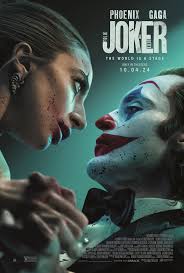Breanna Tillie
Suspense, questions of morality and obsession all tend to come together in the making of a well-done psychological thriller. Are the supposed villains of a story truly evil or are they simply misunderstood with having deeply rooted insecurities and heartbreaks that motivate their behavior? Can a person’s despair descend so deeply into madness that they lose their ability to distinguish between right and wrong? Are monsters born with the blackness of their hearts or is this lack of empathy a coping mechanism that’s been created by a lifetime of hurt?
“Joker: Folie à Deux,” released on Oct. 4, invites viewers into the darker sides of the human psyche as this sequel explores Arthur Fleck being held accountable for his murders as “The Joker” while simultaneously falling in love.
This film dedicates much of its storytelling to developing the relationship between Arthur, played by Joaquin Phoenix, and Lee, played by Lady Gaga. The relationship between these two insane characters is chaotic and eventually reveals itself to be highly manipulative, yet intriguing. Arthur falls in love with the fact that Lee claims to share in his struggle to survive in a society that has been unfair. This makes the toxicity of their bond, which appears obvious to the viewer, understandable for a character such as Arthur. This brilliantly displays the extent of his twisted reality. The chemistry between the two actors was electric and enjoyable to watch.
Lee’s obsession with Arthur’s Joker persona is disturbing and destructive, yet it was difficult not to celebrate Arthur finally getting a small taste of what he believes to be genuine love and care. This makes it all the more heartbreaking when he renounces his persona as Joker, which leads to Lee’s abandonment of him.
Arthur, with all of his wounds, trauma and social awkwardness, was dismissed and spat on by the world. Joker, with his quick wit and charm, was accepted, which was the true desire of Arthur. The cost of being Joker meant that he must be a murderer. Being the murderous Joker was the price of admission into a world that otherwise rejected him. This allows viewers who enjoy the intellectual complexity of moral ambiguity to mull over the question of whether or not this villain can be understood.
This film also contains many scenes in a courthouse, with Arthur being on trial for his murders. Here, we see that while Arthur’s taking on of the Joker persona may be justified due to his trauma, his murders have created trauma for others as well. This offers a social commentary, or perhaps a mere opening for discussion among viewers, about how the trauma of one person can create a cycle of trauma for a number of other people if it is not examined with compassion.
However, the musical component of such a dark film appears to be random and unnecessary. There is a chance that this artistic choice was intentional to amplify the unease of the film, but it seems as if the directors did this to primarily take advantage of having a talented singer like Lady Gaga in the movie.
The ending to the film was also incredibly unsettling, though that may not be a drawback. It does, for those who ponder the ending deeply enough, explain the legacy of “The Joker” and how a murderous villain can be, in a twisted way, a source of inspiration.
You may also like
-
UWG Fails to Protect Student Safety From Radical Conservative Rhetoric Under the Guise of Free Speech
-
UWG’s Ingram Library Hosts Pop-Up Study Spot to Help Students Prepare for Finals Week
-
UWG Offers Mental Health Support And Academic Services To Maintain Student Success During Finals Week
-
UWG Alumnus Shares His Experience Exploring the Underground Flood Channels of Las Vegas
-
Georgia Students Simulate the Struggles of Dementia
